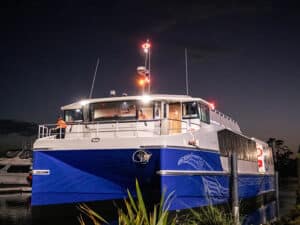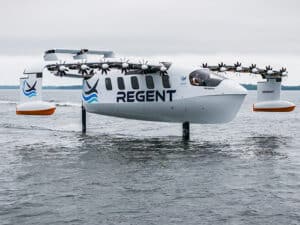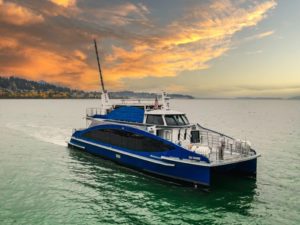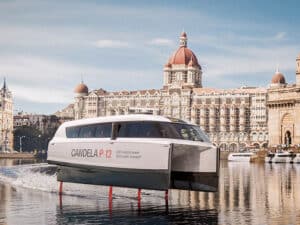
Shore power: ABB gives maritime the scoop
Written by Heather Ervin
Andrew Orvieto of ABB talks to the TTB 2023 audience in March.
The global push to decarbonize has led to the development and implementation of hundreds of vessels with batteries onboard, enabling some zero-emissions operation. These hybrid and electric vessels need some means of recharging their batteries, and ABB says that the most effective way to charge is utilizing shore power. No matter the power source, it is cheaper and better for the environment to charge batteries from shore power over running engines locally.
Andrew “Drew” Orvieto, senior manager – passenger vessels for ABB, tells us more on shoreside charging in the Marine Log exclusive Q&A.
Marine Log (ML): First things first. Why is shoreside electrical infrastructure needed?
Andrew Orvieto (AO): People are likely familiar with cold ironing, which is related but altogether different from shore charging. Cold ironing uses shore power to directly supply the AC loads on a vessel and allows operators to shut down their generators while in port as an emissions reduction measure. In contrast, shore charging is all about charging the batteries onboard a vessel, often via short, high-power pulses from the local grid, so the batteries can then provide power onboard the vessel anytime as required.
The prevalence of shore charging is growing, particularly in the ferry market where vessels have predictable operational profiles and known start and end points where charging connections can be made.
We tend to think of shore charging as the battery-electric equivalent of bunkering for fuel. Depending on a vessel’s operational profile, there many different options for how to accomplish the shore charging, from fast, automatic connections with lots of power that take mere minutes, to slower, manual connections which require an overnight session at lower power levels.
The biggest infrastructure challenge is the energy grid itself. It’s all about getting the energy from the grid to the right place and at the right levels for efficient charging. We have the technology for the shoreside electrical infrastructure, but there also needs to be a suitable grid connection with the capacity to meet the demand for short, high-power charging cycles.
Many operators are servicing remote areas where it can be difficult to bring the power where it needs to be, so there could be significant grid modifications and improvements required to implement a shore charging solution. Funding such improvements remains a challenge for private operators that don’t have access to public grant money.
ML: What cable management solutions are available to ferry operators?
AO: Ferry operators today have several options to consider when designing and integrating a shore charging system. The overall system configuration is based on the vessel arrangement: double ended ferries typically use bow chargers, while traditional ferry designs use side chargers, but we’ve also come across some unique situations that called for custom solutions. For example, some routes will have systems at one end only, likely due to cost and/or infrastructure constraints.
A charging system can utilize manual or automated connections depending on multiple factors, including the time at the dock available to charge, the power transfer requirements in relation to the size of the battery system onboard the vessel, the power level available from the local grid.
Higher power, more automated systems are more expensive but are great for applications with minimal time at the dock, while lower power, more manual systems are more budget-friendly but require more time at the dock to charge. In some cases, a combination of a fast-charging system during the daytime operations and a slow-charging system for nighttime when the vessel is not in service can be a great solution.
It all comes down to the individual situation we’re trying to design for. We analyze the operational profile in detail, looking at the power consumption and timing of each phase (transit, docking/maneuvering, and loading/unloading). The charging system, including the cable management and connections, also needs to be able to compensate somehow for the environmental variability like tidal fluctuations and wave activity, so there are quite a few variables we must design for.
This is the real value of our role as a systems integrator—we analyze the holistic situation, including the vessel’s operational profile and the various constraints (cost, infrastructure, environmental conditions, etc.), and ultimately provide the most efficient and cost-effective charging solution for the ferry operator.
ML: What is the cost in relation to overall cost of a ferry system?
AO: The cost will really depend on the specifics of the application in question, including the vessel’s design and operational profile (charging time, energy storage capacity, etc.). It’s a dynamic situation right now, given the significant infrastructural requirements involved compared to the funding available. Some ferry operators are now building the infrastructure with the potential to serve multiple vessels but may only have the budget available to build one new vessel. As more vessels come into service in the coming years, the infrastructure investment will have already been made, meaning the payback period will become shorter for these operators.
There is perhaps another case to be made with the introduction of the Megawatt Charging System, which aims to provide more commonality to shore charging systems, which again in the long run will reduce costs by providing a common platform for future vessels to utilize existing infrastructure.
In general, the cost of shore charging is not to be underestimated in terms of cost or complexity. It is therefore critical for ferry operators to select a competent and experienced systems integrator to guide them through the process of design and implementation to ensure that they get a cost-effective solution.
ML: Can you cite some case studies that have taught you some lessons in shore charging? (perhaps Maid of the Mist?)
AO: ABB has been the systems integrator for over 50 vessels with onboard energy storage many with shore charging, so we’ve been very fortunate to gain a lot of experience and learn some important lessons during the implementation of these projects. First and foremost, we’ve found that it is critical to involve the shoreside electrical contractor(s) as early in the design process as possible. Shore charging is still relatively new in the context of the marine industry, and the regulatory and standards environments are not yet mature.
Therefore, understanding the local requirements (grid interconnection specifications, UL regulations and equipment certifications, thermal management, etc.) is crucial to be able to develop the appropriate systems both onboard and shoreside. Ideally, the vessel and shore charging systems will be engineered in tandem to avoid any automation issues.
In addition, it is important to consider the fleet when implementing shore charging systems. Most ferry operators run multiple vessels, each with their own requirements and arrangements, and these vessels can stop at a variety of piers with potentially different local infrastructure. Mapping out the entirety of a fleet’s operation can help maintain a holistic perspective. The goal is to standardize when possible, enabling more flexibility for the operator to shift vessels and/or crew around as needed.
ML: Finally, what does ABB have planned for the future of shoreside electrical infrastructure?
AO: It is such an exciting time to be in our industry, with the pace of innovation seemingly picking up every day. This is especially true when it comes to electrification, with batteries and charging systems continuously improving. The innovation is driven by higher volume transportation segments like automotive and off-highway EVs, which ABB is involved with as well.
Our expectation is that we will see many more battery electric projects, particularly in the ferry market, which will enable more standardization and help push for more maturity on the regulatory side. Battery technology will continue to improve, as will the charging systems that keep them running. Many companies, ABB included, are developing Megawatt Charging Systems for heavy-duty electric vehicles, offering faster, more efficient, and more powerful charging with automatic connections.




